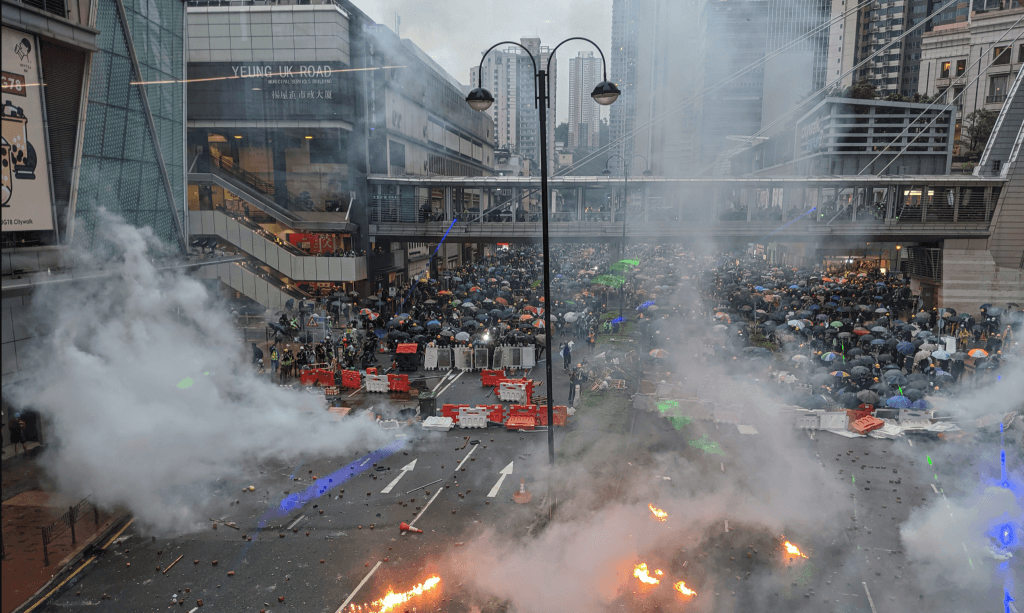Hong Kongers rage against smart lampposts, Chinese surveillance
By Matt Field | August 27, 2019
 A recent protest in Hong Kong. Credit: Studio Incendo via Wikimedia Commons. CC BY-2.0.
A recent protest in Hong Kong. Credit: Studio Incendo via Wikimedia Commons. CC BY-2.0.
In 1989, Germans cheered as parts of the Berlin Wall were demolished. Now, after weeks of protest against their local and national governments, demonstrators in Hong Kong are the ones exercising the age-old cathartic urge to topple, smash, and otherwise destroy the symbols of one’s oppression. They’re sawing through tall lampposts that have sprouted in the city and that protesters believe contain surveillance technology used to spy on them and reveal their identities to authorities.
Using electric saws, the protestors cut the bases of the tall structures before pulling on ropes that they’ve rigged up to the lampposts. So far, five have been targeted, Chris Lau, a reporter for the South China Morning Post, wrote on Twitter. Lau’s feed contains video of protestors using their umbrellas to shield the identity of the people working on the base of one of the lampposts. As the structure falls, the crowd cheers wildly.
After some 30 tense mintues, protesters took down a smart lamp post pic.twitter.com/MFKhqNRkhf
— Chris Lau (@hkchrislau) August 24, 2019
Hong Kong authorities claim the lampposts monitor traffic, weather, and air quality and don’t contain facial recognition technology. But according to the Post, one prominent pro-democracy group questions whether the manufacturer of the lampposts is linked to a firm involved in mainland China’s video surveillance network, Skynet. Either way, anxiety over the lampposts dovetails with the concern protestors have over perceived surveillance by the mainland. “Hong Kong people’s private information is already being extradited to China,” a protest organizer told the Australian broadcast network ABC News. “We have to be very concerned.”
Mass protests began in Hong Kong earlier this summer, after the government pressed forward with a bill allowing Hong Kong citizens to be extradited to mainland China; such extradition was not previously allowed under the one-country, two systems relationship between Hong Kong and the People’s Republic of China. Activists have a variety of grievances, including demands that the government abandon the extradition measure and address police brutality. Beijing has sent signals—the most menacing of which involve the massing of paramilitary forces in neighboring Guangdong Province—that it may intervene in the Hong Kong protests.
Some 1.7 million people, a quarter of the city’s population, attended one protest a week ago.
The idea that China’s technologically advanced and growing surveillance architecture might be wielded against Hong Kong protestors is not unfounded. Travelers to the mainland have reported that authorities at the border are searching through photos on people’s phones and inspecting digital devices to see if they have been involved in the protests. Beijing’s sweeping surveillance capabilities are well known, and China already has in place some 200 million security cameras.
Together, we make the world safer.
The Bulletin elevates expert voices above the noise. But as an independent nonprofit organization, our operations depend on the support of readers like you. Help us continue to deliver quality journalism that holds leaders accountable. Your support of our work at any level is important. In return, we promise our coverage will be understandable, influential, vigilant, solution-oriented, and fair-minded. Together we can make a difference.
Keywords: China, Hong Kong, extradition bill, smart lampposts, surveillance
Topics: Disruptive Technologies, What We’re Reading














